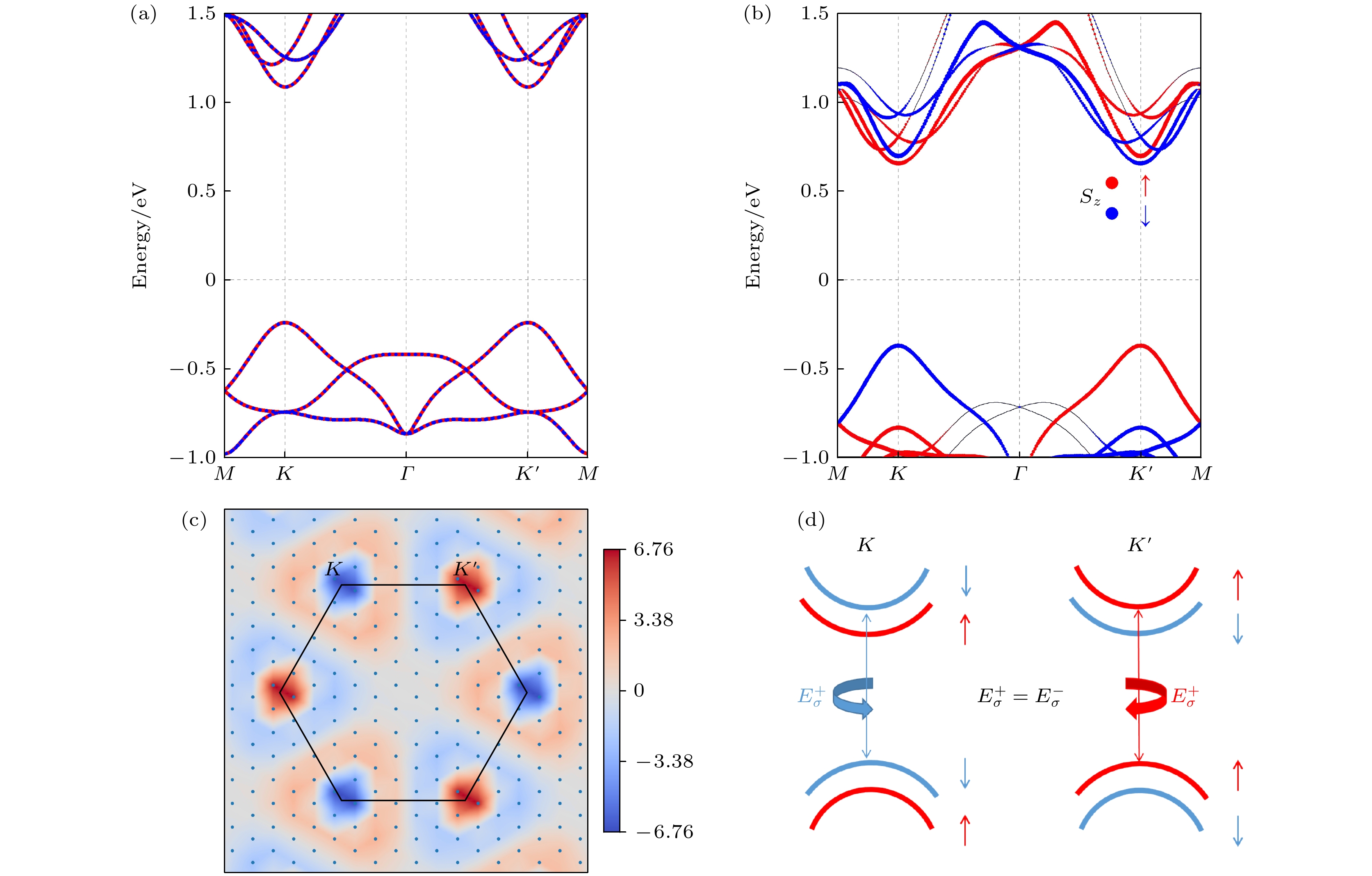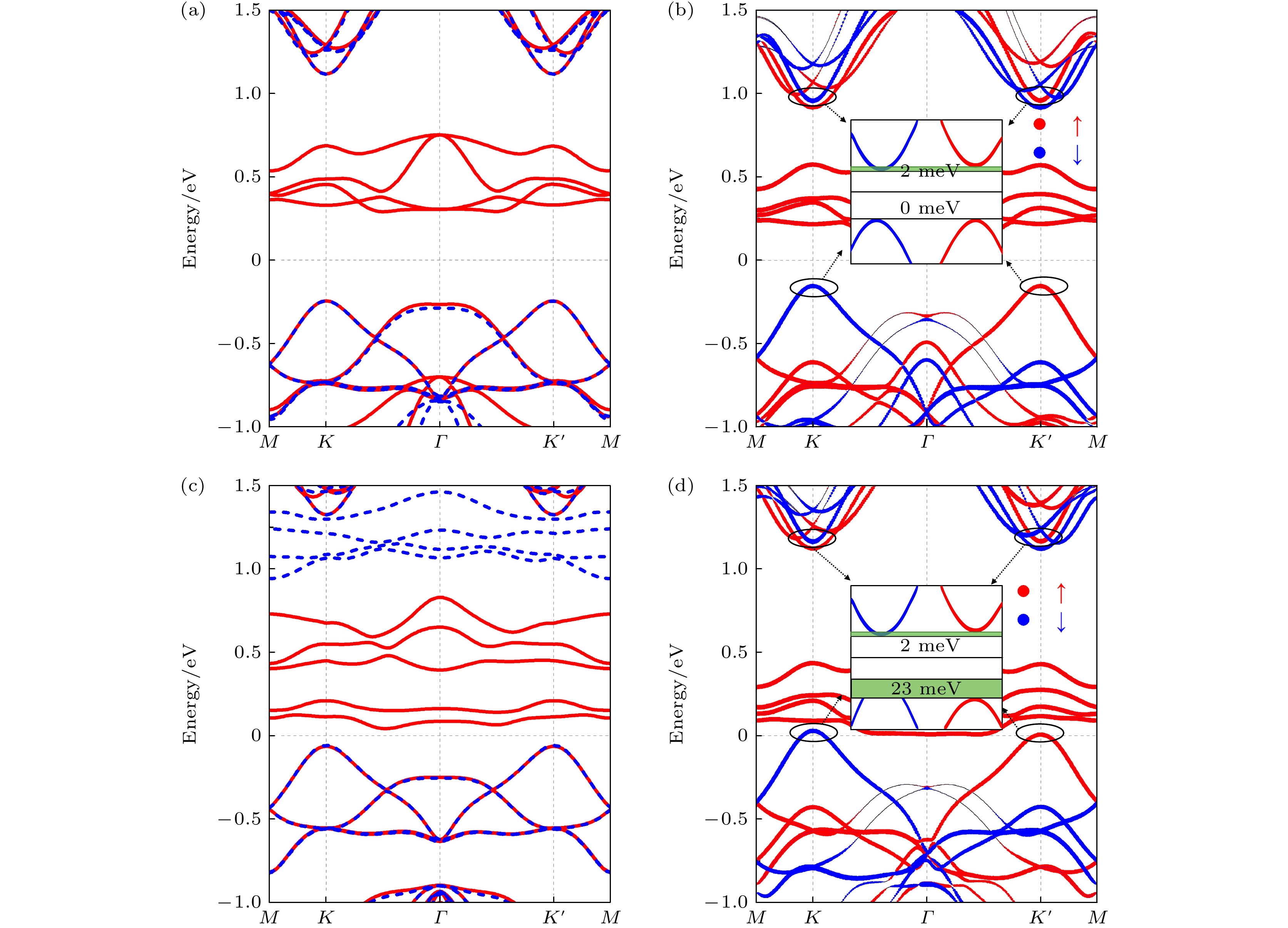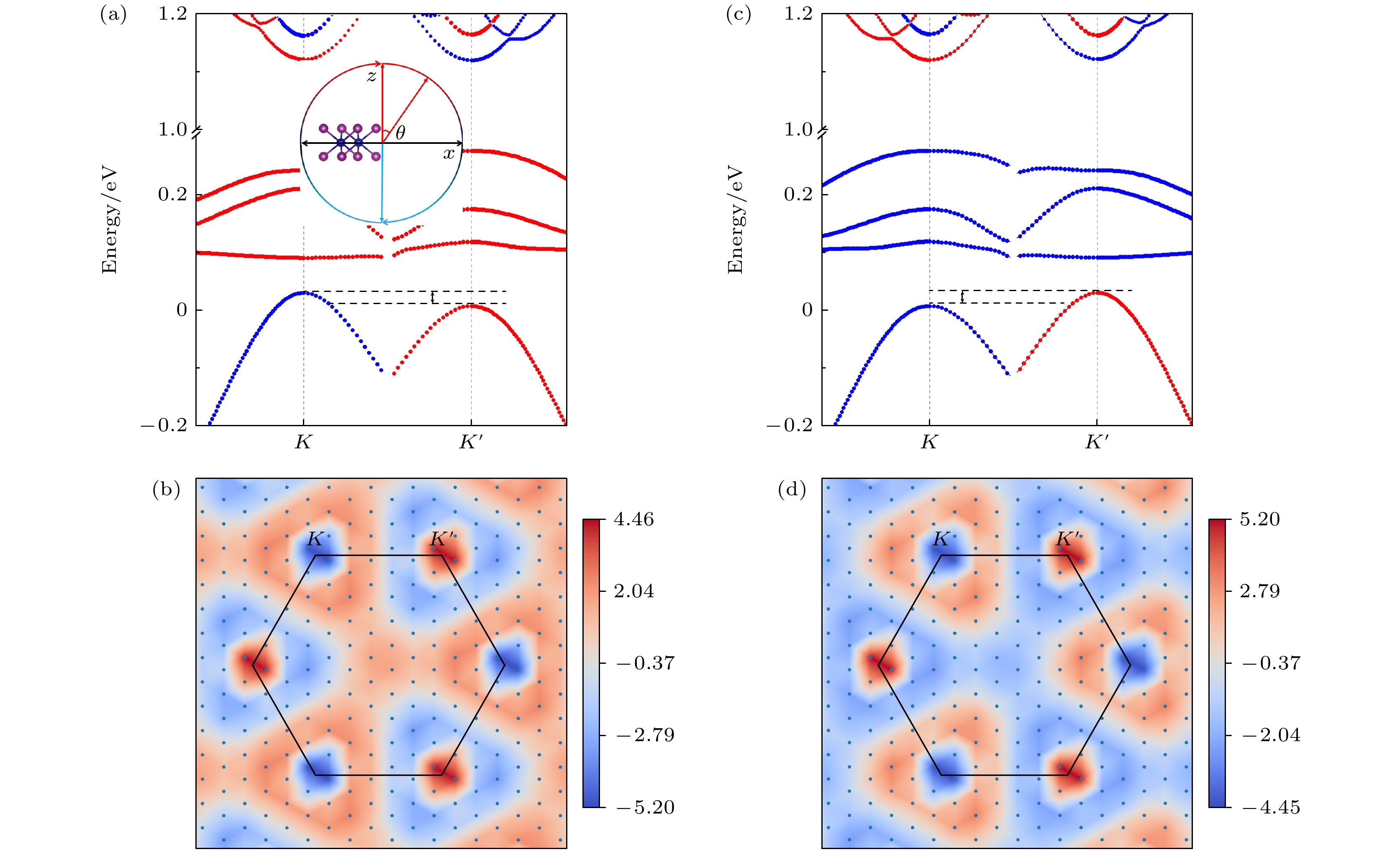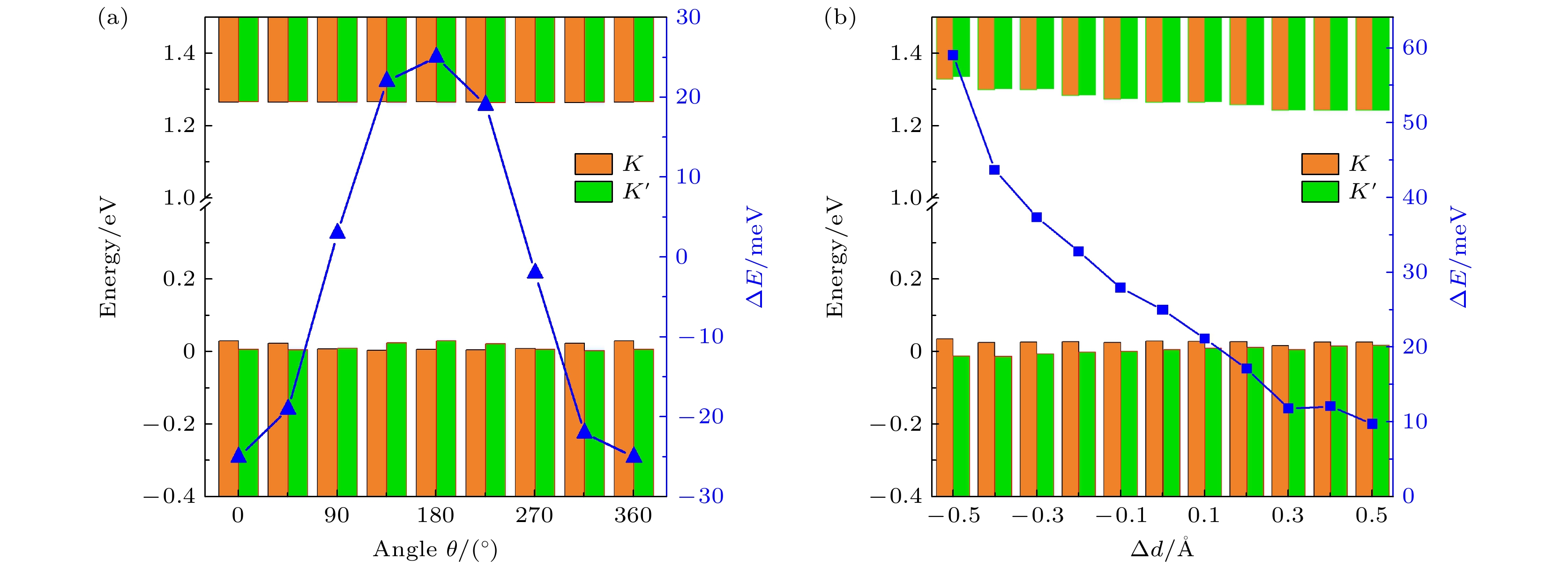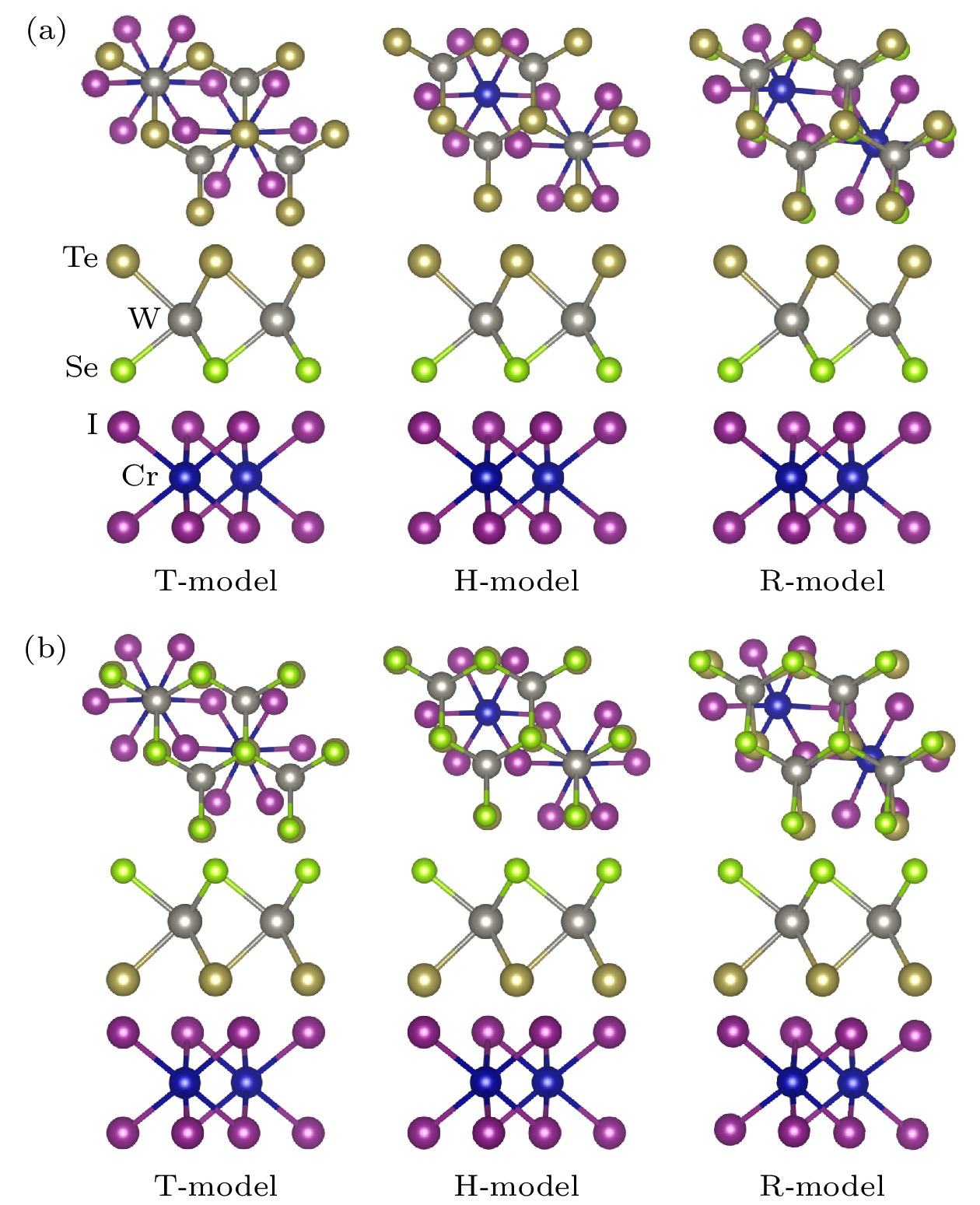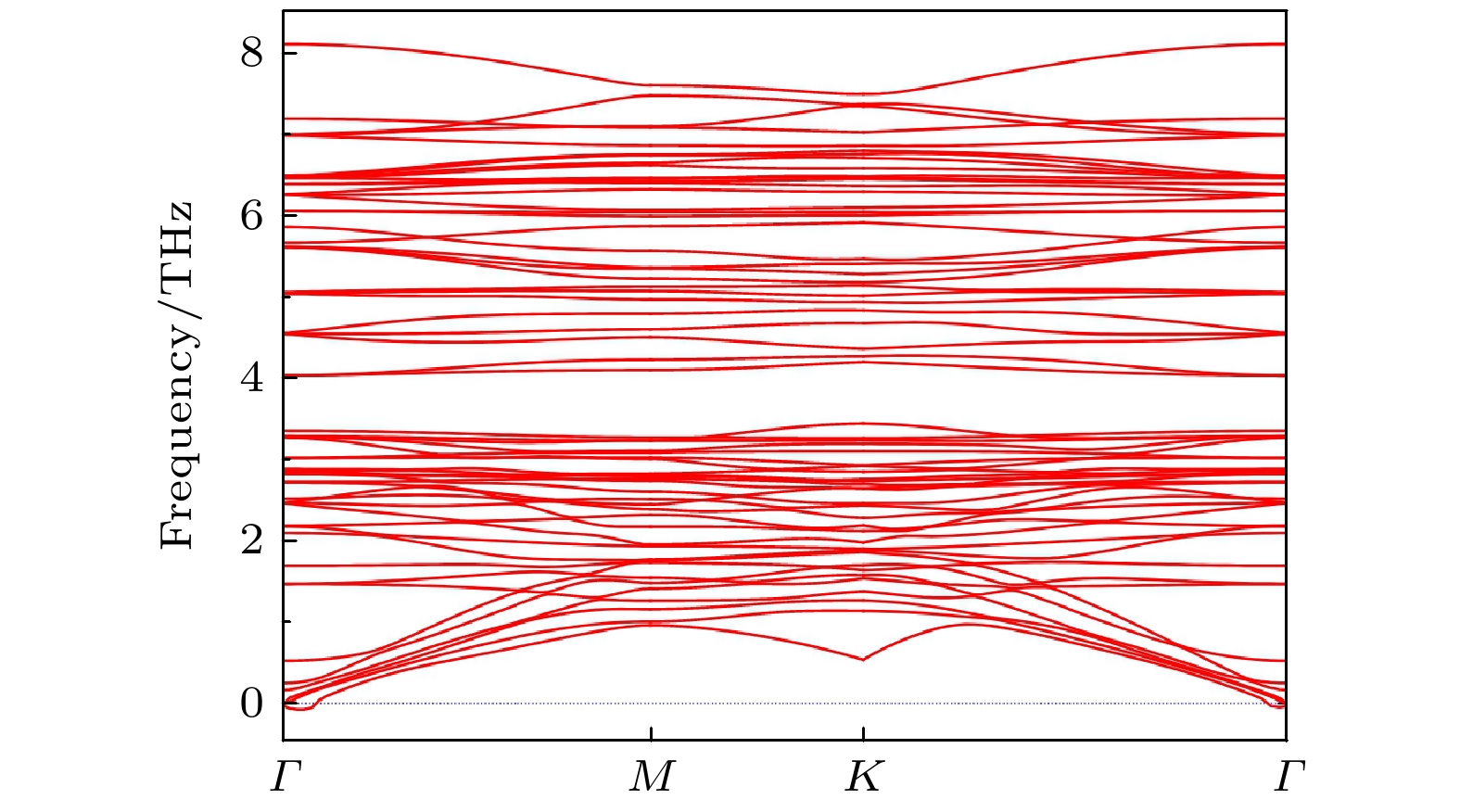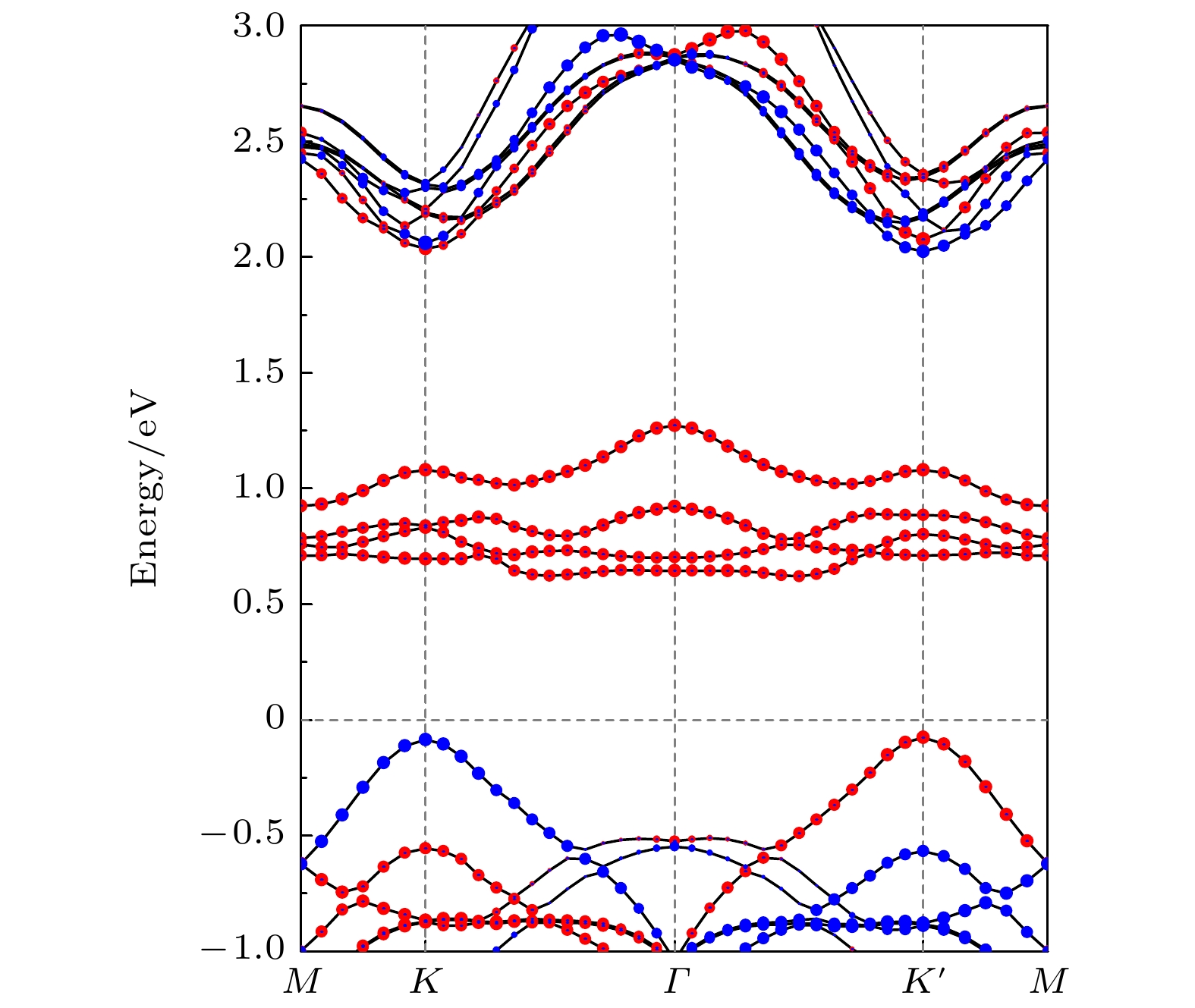-
范德瓦耳斯异质结构为设计二维材料的电子、自旋特性提供了丰富的平台. 解除谷简并是利用谷自由度处理和存储谷电子信息的必要条件, 二维范德瓦耳斯异质结构中的邻近效应为定制邻近材料的电子能带结构提供了可控的方法. 本文基于第一性原理计算, 研究了 WSeTe /CrI3 范德瓦耳斯异质结的电子能带结构. 通过施加垂直应变与改变衬底磁矩方向对能谷进行调控. 单层WSeTe在K与K' 存在一对简并能谷, 在自旋-轨道耦合作用与磁性衬底CrI3邻近效应作用下会产生较大的谷劈裂和谷极化. 异质结产生的谷极化为25 meV. 施加垂直应变可以有效地调节能谷极化, 减小层间距可以增大谷极化. 此外, 衬底磁矩方向变化可以有效调控谷极化的方向和大小. 本文研究结果为谷自由度的调控提供了一个有效的方法, 为谷电子学和自旋电子学的应用提供了新的途径.The valley degree of freedom, besides charge and spin, can be used to process information and perform logic operations as well, with the advantage of low power consumption and high speed. The effective manipulation of valley degrees of freedom is essential for their practical applications in valleytronics and spintronics. In this work, the effective strategy is investigated for the valley manipulation of the WSeTe/CrI3 van der Waals heterojunction with about 2% lattice mismatch by the first-principles calculations. The valley degree of freedom in WSeTe can be modulated by the magnetism of Cr atoms in the substrate via the magnetic proximity effect, including the vertical strain method and the rotation of the magnetic moments of Cr atoms. First-principles calculations are performed by using the VASP software package with the generalized gradient approximation functional in PerdewBurke-Ernzerhof (PBE) form. The spin-orbit coupling is considered when calculating the band structure to investigate the valley properties. The dependence of valley polarization on both vertical strain and the substrate’s magnetic moment direction has been systematically analyzed. There are two different stacking configurations for the WSeTe/CrI3 heterojunction with Te/Se atoms at the interface, namely Te-stacking and Se-stacking. Although single-layer WSeTe does not have valley polarization, the Te-stacked and Se-stacked WSeTe/CrI3 heterojunctions exhibit valley polarizations of 25 meV and 2 meV, respectively, which is influenced by spin-orbit coupling and the proximity effect of the magnetic substrate CrI3, indicating the importance of the stack configuration. The Te-stacked configuration of the heterojunction has a larger valley polarization due to stronger orbital hybridization between W atoms in WSeTe layer and Cr atoms in CrI3 layer. The application of vertical strain, which effectively tunes the interlayer distance, significantly regulates the valley polarization. Specifically, the valley polarization is increased to 59 meV when the interlayer distance decreases by 0.5 Å, while it decreases to 10 meV when the interlayer distance increases by 0.5 Å. Additionally, when the magnetic moment of the CrI3 substrate rotates by 360°, the valley polarization changes between –25 meV and 25 meV. It reaches a maximum value when the magnetic moment is aligned along the out-of-plane direction. This study demonstrates that the valley degree of freedom in the WSeTe/CrI3 van der Waals heterojunction can be effectively manipulated by adjusting the interlayer distance through vertical strain and by controlling the magnetic moment direction of the substrate. These findings provide valuable insights into the design and application of valleytronic and spintronic devices based on two-dimensional van der Waals heterostructures.
-
Keywords:
- valley /
- heterojunction /
- magnetic proximity /
- first principles
[1] Gunawan O, Shkolnikov Y P, Vakili K, Gokmen T, De Poortere E P, Shayegan M 2006 Phys. Rev. Lett. 97 186404
 Google Scholar
Google Scholar
[2] Rycerz A, Tworzydło J, Beenakker C W J 2007 Nat. Phys. 3 172
 Google Scholar
Google Scholar
[3] Sun Z H, Guan H M, Fu L, Shen B, Tang N 2021 Acta Phys. Sin. 70 027302 [孙真昊, 管鸿明, 付雷, 沈波, 唐宁 2021 70 027302]
 Google Scholar
Google Scholar
Sun Z H, Guan H M, Fu L, Shen B, Tang N 2021 Acta Phys. Sin. 70 027302
 Google Scholar
Google Scholar
[4] Schaibley J R, Yu H, Clark G, Rivera P, Ross J S, Seyler K L, Yao W, Xu X 2016 Nat. Rev. Mater. 1 16055
 Google Scholar
Google Scholar
[5] Xiao D, Liu G B, Feng W, Xu X, Yao W 2012 Phys. Rev. Lett. 108 196802
 Google Scholar
Google Scholar
[6] Aivazian G, Gong Z, Jones A M, Chu R L, Yan J, Mandrus D G, Zhang C, Cobden D, Yao W, Xu X 2015 Nat. Phys. 11 148
 Google Scholar
Google Scholar
[7] MacNeill D, Heikes C, Mak K F, Anderson Z, Kormanyos A, Zolyomi V, Park J, Ralph D C 2015 Phys. Rev. Lett. 114 037401
 Google Scholar
Google Scholar
[8] Srivastava A, Sidler M, Allain A V, Lembke D S, Kis A, Imamoğlu A 2015 Nat. Phys. 11 141
 Google Scholar
Google Scholar
[9] Xu S, Si C, Li Y, Gu B L, Duan W 2021 Nano Lett. 21 1785
 Google Scholar
Google Scholar
[10] Cheng Y C, Zhang Q Y, Schwingenschlögl U 2014 Phys. Rev. B 89 155429
 Google Scholar
Google Scholar
[11] Ramasubramaniam A, Naveh D 2013 Phys. Rev. B 87 195201
 Google Scholar
Google Scholar
[12] 张德贺, 周文哲, 李奥林, 欧阳方平 2021 70 096301
 Google Scholar
Google Scholar
Zhang D H, Zhou W Z, Li A L, Ouyang F P 2021 Acta Phys. Sin. 70 096301
 Google Scholar
Google Scholar
[13] Qi J S, Li X, Niu Q, Feng J 2015 Phys. Rev. B 92 121403
 Google Scholar
Google Scholar
[14] Zhang Q, Yang S A, Mi W, Cheng Y, Schwingenschlogl U 2016 Adv. Mater. 28 959
 Google Scholar
Google Scholar
[15] Zheng G B, Zhang B, Duan H M, Zhou W Z, Ouyang F P 2023 Physica E 148 115616
 Google Scholar
Google Scholar
[16] 邓霖湄, 司君山, 吴绪才, 张卫兵 2022 71 147101
 Google Scholar
Google Scholar
Deng L M, Si J S, Wu X C, Zhang W B 2022 Acta Phys. Sin. 71 147101
 Google Scholar
Google Scholar
[17] Yao W, Xiao D, Niu Q 2008 Phys. Rev. B 77 235406
 Google Scholar
Google Scholar
[18] Mak K F, He K, Shan J, Heinz T F 2012 Nat. Nanotechnol. 7 494
 Google Scholar
Google Scholar
[19] Liu H, Zhang Z, Li Y, Wu Y, Wu Z, Li X, Zhang C, Xu F, Kang J 2023 Adv. Photon. Nexus 2 026007
 Google Scholar
Google Scholar
[20] Stier A V, McCreary K M, Jonker B T, Kono J, Crooker S A 2016 Nat. Commun. 7 10643
 Google Scholar
Google Scholar
[21] Abid A, Haneef M, Ali S, Dahshan A 2022 J. Solid State Chem. 311 123159
 Google Scholar
Google Scholar
[22] Mehdipour H, Kratzer P 2024 Phys. Rev. B 109 085425
 Google Scholar
Google Scholar
[23] Sattar S, Larsson J A, Canali C M, Roche S, Garcia J H 2022 Phys. Rev. B 105 L041402
 Google Scholar
Google Scholar
[24] Norden T, Zhao C, Zhang P, Sabirianov R, Petrou A, Zeng H 2019 Nat. Commun. 10 4163
 Google Scholar
Google Scholar
[25] Hu T, Zhao G D, Gao H, Wu Y B, Hong J S, Stroppa A, Ren W 2020 Phys. Rev. B 101 125401
 Google Scholar
Google Scholar
[26] Zhang W L, Zhu H R, Zhang W Q, Wang J, Zhang T T, Yang S R, Shao B, Zuo X 2024 Appl. Surf. Sci. 647 158986
 Google Scholar
Google Scholar
[27] Ye Y, Xiao J, Wang H L, Ye Z L, Zhu H R, Zhao M, Wang Y, Zhao J H, Yin X B, Zhang X 2016 Nat. Nanotechnol. 11 598
 Google Scholar
Google Scholar
[28] Lu A Y, Zhu H R, Xiao J, Chuu C P, Han Y, Chiu M H, Cheng C C, Yang C W, Wei K H, Yang Y, Wang Y, Sokaras D, Nordlund D, Yang P, Muller D A, Chou M Y, Zhang X, Li L J 2017 Nat. Nanotechnol. 12 744
 Google Scholar
Google Scholar
[29] Zhang J, Jia S, Kholmanov I, Dong L, Er D, Chen W, Guo H, Jin Z, Shenoy V B, Shi L, Lou J 2017 ACS Nano 11 8192
 Google Scholar
Google Scholar
[30] Hajra D, Sailus R, Blei M, Yumigeta K, Shen Y, Tongay S 2020 ACS Nano 14 15626
 Google Scholar
Google Scholar
[31] Trivedi D B, Turgut G, Qin Y, Sayyad M Y, Hajra D, Howell M, Liu L, Yang S, Patoary N H, Li H, Petric M M, Meyer M, Kremser M, Barbone M, Soavi G, Stier A V, Muller K, Yang S, Esqueda I S, Zhuang H, Finley J J, Tongay S 2020 Adv. Mater. 32 2006320
 Google Scholar
Google Scholar
[32] Yang S Y, Shi D R, Wang T, Yue X Y, Zheng L, Zhang Q H, Gu L, Yang X Q, Shadike Z, Li H, Fu Z W 2020 J. Mater. Chem. A 8 25739
 Google Scholar
Google Scholar
[33] Guo S D, Zhu J X, Yin M Y, Liu B G 2022 Phys. Rev. B 105 104416
 Google Scholar
Google Scholar
[34] Zhang L, Zhao Y, Liu Y, Gao G 2023 Nanoscale 15 18910
 Google Scholar
Google Scholar
[35] Chen Y K, Zhao X S, An Y K 2024 Phys. Rev. B 109 125421
 Google Scholar
Google Scholar
[36] Kresse G, Furthmuller J 1996 Phys. Rev. B 54 11169
 Google Scholar
Google Scholar
[37] Grimme S, Antony J, Ehrlich S, Krieg H 2010 J. Chem. Phys. 132 154104
 Google Scholar
Google Scholar
[38] Monkhorst H J, Pack J D 1976 Phys. Rev. B 13 5188
 Google Scholar
Google Scholar
[39] Dudarev S L, Botton G A, Savrasov S Y, Humphreys C, Sutton A P 1998 Phys. Rev. B 57 1505
 Google Scholar
Google Scholar
[40] Kim H J https://github.com/Infant83/VASPBERRY [2024-7-11]
[41] Hu T, Jia F H, Zhao G D, Wu J Y, Stroppa A, Ren W 2018 Phys. Rev. B 97 235404
 Google Scholar
Google Scholar
[42] Webster L, Yan J A 2018 Phys. Rev. B 98 144411
 Google Scholar
Google Scholar
[43] Ma Z, Huang P, Li J, Zhang P, Zheng J X, Xiong W, Wang F, Zhang X W 2022 npj Comput. Mater. 8 11
 Google Scholar
Google Scholar
[44] Zhang H J, Li Y F, Hou J H, Du A J, Chen Z F 2016 Nano Lett. 16 6124
 Google Scholar
Google Scholar
[45] Shao Y, Shao M, Kawazoe Y, Shi X, Pan H 2018 J. Mater. Chem. A 6 10226
 Google Scholar
Google Scholar
[46] Yang C, Li J, Liu X L, Bai C L 2023 Phys. Chem. Chem. Phys. 25 28796
 Google Scholar
Google Scholar
-
图 3 WSeTe/CrI3异质结能带图 (a)不考虑SOC的Se构型; (b)考虑SOC的Se构型; (c)不考虑SOC的Te构型; (d)考虑SOC的Te构型; 蓝色虚线代表自旋向下, 红色实线代表自旋向上; 插图为能谷放大视图
Fig. 3. Band structures of WSeTe/CrI3: (a) The band structures of Se model without SOC; (b) the band structures of Se model with SOC; (c) the band structures of Te model without SOC; (d) the band structures of Te model with SOC, the blue dashed lines represent spin-down, and the red lines represent spin-up. The insets are enlarged local views.
图 4 WSeTe/CrI3异质结Te构型的投影能带图 (a)原子投影能带; (b) CrI3与WSeTe层投影能带; (c) W原子Sz方向自旋投影能带, 其中红色和蓝色代表自旋向上和向下的能带, ${E_\sigma }$代表导带谷到价带谷的能量差
Fig. 4. Projected band structures of the Te-model WSeTe/CrI3 heterojunction: (a) Atom projected band structures; (b) layer projected band structures of CrI3 and WSeTe; (c) projected band structures of W along the Sz direction of spin, where the red and blue circles correspond to spin-up and spin-down bands, ${E_\sigma }$represents the energy difference from the conduction band valley to the valence band valley.
图 5 K与K' 附近能带与Berry曲率 (a)磁矩+Z (θ = 0°)方向的能带, 插图为磁矩方向示意图; (b) 磁矩+Z (θ = 0°)方向的Berry曲率; (c)磁矩–Z (θ = 180°)方向的能带; (d)磁矩–Z (θ = 180°)方向的Berry曲率; 红色和蓝色代表自旋向上和向下的能带
Fig. 5. Bands and Berry curvature near the K and K' points: (a) Band structures for the magnetic moment along the +Z (θ = 0°) direction, with an inset diagram illustrating the direction of the magnetic moment; (b) Berry curvature for the magnetic moment along the +Z (θ = 0°) direction; (c) bands structures for the magnetic moment along the –Z (θ = 180°) direction; (d) Berry curvature for the magnetic moment along the –Z (θ = 180°) direction; the red and blue circles correspond to spin-up and spin-down bands.
图 6 (a)不同Cr磁矩方向的能谷及谷极化大小, 其中蓝色线条代表不同磁矩方向下的谷极化; (b)不同层间距下能谷及谷极化大小, 其中蓝色线条代表不同层间距下的谷极化${\text{|}}\Delta {E_\sigma }{\text{|}}$大小; 橙色和绿色柱状图分别表示了K与K' 处谷的能量
Fig. 6. (a) Valley and valley polarization for different Cr magnetic moments, where blue lines represent the valley polarization under different magnetization angles; (b) valley and valley polarization under different interlayer distance, where blue lines represent the valley polarization magnitudes at different interlayer distance. The orange and green bar charts indicate the energy of the valleys at the K and K' , respectively.
表 A1 6种不同结构的晶格常数、层间距和结合能
Table A1. Lattice constant, interlayer distance, and binding energy for six different models.
堆叠方式 晶格常数a = b/Å 层间距d/Å 结合能Eb/eV T-Te 6.84 3.79 –3.59 T-Se 6.84 3.61 –3.58 H-Te 6.83 3.85 –3.52 H-Se 6.83 3.67 –3.51 R-Te 6.84 3.78 –3.58 R-Se 6.84 3.52 –3.58 -
[1] Gunawan O, Shkolnikov Y P, Vakili K, Gokmen T, De Poortere E P, Shayegan M 2006 Phys. Rev. Lett. 97 186404
 Google Scholar
Google Scholar
[2] Rycerz A, Tworzydło J, Beenakker C W J 2007 Nat. Phys. 3 172
 Google Scholar
Google Scholar
[3] Sun Z H, Guan H M, Fu L, Shen B, Tang N 2021 Acta Phys. Sin. 70 027302 [孙真昊, 管鸿明, 付雷, 沈波, 唐宁 2021 70 027302]
 Google Scholar
Google Scholar
Sun Z H, Guan H M, Fu L, Shen B, Tang N 2021 Acta Phys. Sin. 70 027302
 Google Scholar
Google Scholar
[4] Schaibley J R, Yu H, Clark G, Rivera P, Ross J S, Seyler K L, Yao W, Xu X 2016 Nat. Rev. Mater. 1 16055
 Google Scholar
Google Scholar
[5] Xiao D, Liu G B, Feng W, Xu X, Yao W 2012 Phys. Rev. Lett. 108 196802
 Google Scholar
Google Scholar
[6] Aivazian G, Gong Z, Jones A M, Chu R L, Yan J, Mandrus D G, Zhang C, Cobden D, Yao W, Xu X 2015 Nat. Phys. 11 148
 Google Scholar
Google Scholar
[7] MacNeill D, Heikes C, Mak K F, Anderson Z, Kormanyos A, Zolyomi V, Park J, Ralph D C 2015 Phys. Rev. Lett. 114 037401
 Google Scholar
Google Scholar
[8] Srivastava A, Sidler M, Allain A V, Lembke D S, Kis A, Imamoğlu A 2015 Nat. Phys. 11 141
 Google Scholar
Google Scholar
[9] Xu S, Si C, Li Y, Gu B L, Duan W 2021 Nano Lett. 21 1785
 Google Scholar
Google Scholar
[10] Cheng Y C, Zhang Q Y, Schwingenschlögl U 2014 Phys. Rev. B 89 155429
 Google Scholar
Google Scholar
[11] Ramasubramaniam A, Naveh D 2013 Phys. Rev. B 87 195201
 Google Scholar
Google Scholar
[12] 张德贺, 周文哲, 李奥林, 欧阳方平 2021 70 096301
 Google Scholar
Google Scholar
Zhang D H, Zhou W Z, Li A L, Ouyang F P 2021 Acta Phys. Sin. 70 096301
 Google Scholar
Google Scholar
[13] Qi J S, Li X, Niu Q, Feng J 2015 Phys. Rev. B 92 121403
 Google Scholar
Google Scholar
[14] Zhang Q, Yang S A, Mi W, Cheng Y, Schwingenschlogl U 2016 Adv. Mater. 28 959
 Google Scholar
Google Scholar
[15] Zheng G B, Zhang B, Duan H M, Zhou W Z, Ouyang F P 2023 Physica E 148 115616
 Google Scholar
Google Scholar
[16] 邓霖湄, 司君山, 吴绪才, 张卫兵 2022 71 147101
 Google Scholar
Google Scholar
Deng L M, Si J S, Wu X C, Zhang W B 2022 Acta Phys. Sin. 71 147101
 Google Scholar
Google Scholar
[17] Yao W, Xiao D, Niu Q 2008 Phys. Rev. B 77 235406
 Google Scholar
Google Scholar
[18] Mak K F, He K, Shan J, Heinz T F 2012 Nat. Nanotechnol. 7 494
 Google Scholar
Google Scholar
[19] Liu H, Zhang Z, Li Y, Wu Y, Wu Z, Li X, Zhang C, Xu F, Kang J 2023 Adv. Photon. Nexus 2 026007
 Google Scholar
Google Scholar
[20] Stier A V, McCreary K M, Jonker B T, Kono J, Crooker S A 2016 Nat. Commun. 7 10643
 Google Scholar
Google Scholar
[21] Abid A, Haneef M, Ali S, Dahshan A 2022 J. Solid State Chem. 311 123159
 Google Scholar
Google Scholar
[22] Mehdipour H, Kratzer P 2024 Phys. Rev. B 109 085425
 Google Scholar
Google Scholar
[23] Sattar S, Larsson J A, Canali C M, Roche S, Garcia J H 2022 Phys. Rev. B 105 L041402
 Google Scholar
Google Scholar
[24] Norden T, Zhao C, Zhang P, Sabirianov R, Petrou A, Zeng H 2019 Nat. Commun. 10 4163
 Google Scholar
Google Scholar
[25] Hu T, Zhao G D, Gao H, Wu Y B, Hong J S, Stroppa A, Ren W 2020 Phys. Rev. B 101 125401
 Google Scholar
Google Scholar
[26] Zhang W L, Zhu H R, Zhang W Q, Wang J, Zhang T T, Yang S R, Shao B, Zuo X 2024 Appl. Surf. Sci. 647 158986
 Google Scholar
Google Scholar
[27] Ye Y, Xiao J, Wang H L, Ye Z L, Zhu H R, Zhao M, Wang Y, Zhao J H, Yin X B, Zhang X 2016 Nat. Nanotechnol. 11 598
 Google Scholar
Google Scholar
[28] Lu A Y, Zhu H R, Xiao J, Chuu C P, Han Y, Chiu M H, Cheng C C, Yang C W, Wei K H, Yang Y, Wang Y, Sokaras D, Nordlund D, Yang P, Muller D A, Chou M Y, Zhang X, Li L J 2017 Nat. Nanotechnol. 12 744
 Google Scholar
Google Scholar
[29] Zhang J, Jia S, Kholmanov I, Dong L, Er D, Chen W, Guo H, Jin Z, Shenoy V B, Shi L, Lou J 2017 ACS Nano 11 8192
 Google Scholar
Google Scholar
[30] Hajra D, Sailus R, Blei M, Yumigeta K, Shen Y, Tongay S 2020 ACS Nano 14 15626
 Google Scholar
Google Scholar
[31] Trivedi D B, Turgut G, Qin Y, Sayyad M Y, Hajra D, Howell M, Liu L, Yang S, Patoary N H, Li H, Petric M M, Meyer M, Kremser M, Barbone M, Soavi G, Stier A V, Muller K, Yang S, Esqueda I S, Zhuang H, Finley J J, Tongay S 2020 Adv. Mater. 32 2006320
 Google Scholar
Google Scholar
[32] Yang S Y, Shi D R, Wang T, Yue X Y, Zheng L, Zhang Q H, Gu L, Yang X Q, Shadike Z, Li H, Fu Z W 2020 J. Mater. Chem. A 8 25739
 Google Scholar
Google Scholar
[33] Guo S D, Zhu J X, Yin M Y, Liu B G 2022 Phys. Rev. B 105 104416
 Google Scholar
Google Scholar
[34] Zhang L, Zhao Y, Liu Y, Gao G 2023 Nanoscale 15 18910
 Google Scholar
Google Scholar
[35] Chen Y K, Zhao X S, An Y K 2024 Phys. Rev. B 109 125421
 Google Scholar
Google Scholar
[36] Kresse G, Furthmuller J 1996 Phys. Rev. B 54 11169
 Google Scholar
Google Scholar
[37] Grimme S, Antony J, Ehrlich S, Krieg H 2010 J. Chem. Phys. 132 154104
 Google Scholar
Google Scholar
[38] Monkhorst H J, Pack J D 1976 Phys. Rev. B 13 5188
 Google Scholar
Google Scholar
[39] Dudarev S L, Botton G A, Savrasov S Y, Humphreys C, Sutton A P 1998 Phys. Rev. B 57 1505
 Google Scholar
Google Scholar
[40] Kim H J https://github.com/Infant83/VASPBERRY [2024-7-11]
[41] Hu T, Jia F H, Zhao G D, Wu J Y, Stroppa A, Ren W 2018 Phys. Rev. B 97 235404
 Google Scholar
Google Scholar
[42] Webster L, Yan J A 2018 Phys. Rev. B 98 144411
 Google Scholar
Google Scholar
[43] Ma Z, Huang P, Li J, Zhang P, Zheng J X, Xiong W, Wang F, Zhang X W 2022 npj Comput. Mater. 8 11
 Google Scholar
Google Scholar
[44] Zhang H J, Li Y F, Hou J H, Du A J, Chen Z F 2016 Nano Lett. 16 6124
 Google Scholar
Google Scholar
[45] Shao Y, Shao M, Kawazoe Y, Shi X, Pan H 2018 J. Mater. Chem. A 6 10226
 Google Scholar
Google Scholar
[46] Yang C, Li J, Liu X L, Bai C L 2023 Phys. Chem. Chem. Phys. 25 28796
 Google Scholar
Google Scholar
计量
- 文章访问数: 853
- PDF下载量: 48
- 被引次数: 0














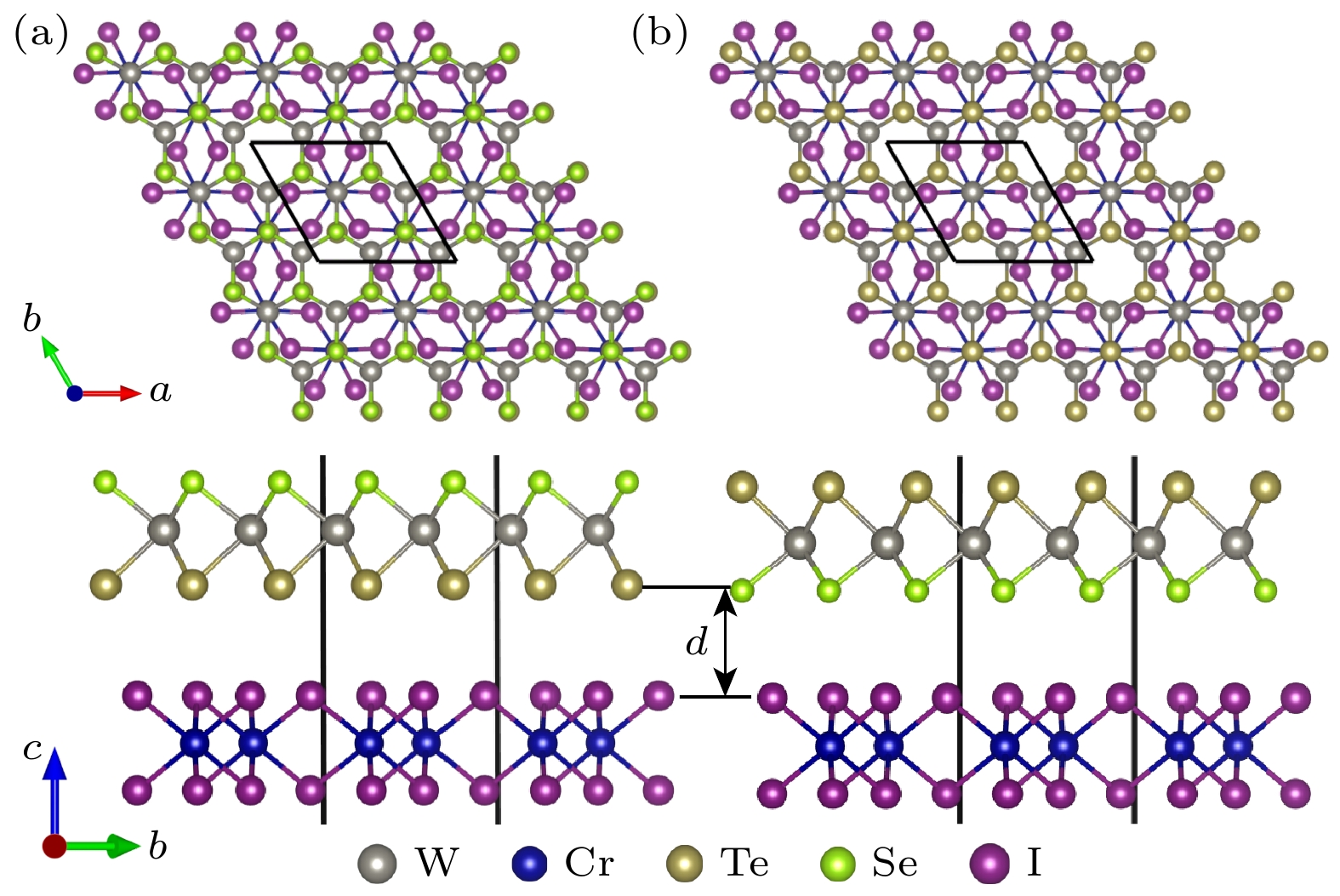
 下载:
下载:
